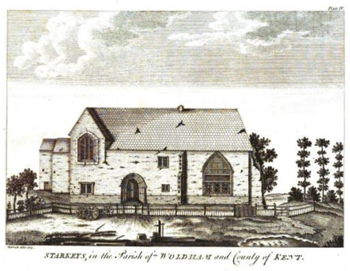MRP: Starkeys
Starkeys
Editorial history
20/09/11, CSG: Created page
THIS ENTRY REQUIRES EDITING
"In this parish [Wouldham], which derives its name from its situation under the wolds or downs, is an ancient house now called Starkeys, near the river Medway; but in times of remote antiquity, it had the repute of a manor, and was known by the name of Woldham parva, or Little Woldham. After sundry descents it came into the inheritance of Sir Humfrey Starkey, one of the barons of the Exchequer in the reign of Henry VII. who erected the present house called after his name....From him it came down to Sir John Lewson, whose son Sir Richard Lewson transferred his right in it to that learned baronet Sir John Marsham, and it is now the property of his descendant the right honourable Robert Lord Romney.
It was built of stone, and was in former times a handsome strong edifice, and much larger than at present, being now only a farm-house; and, when this drawing was made, much out of repair, the great window of the hall being, for the most part, stopped up with bricks and plaister.
Harris says that he "saw at Starkeys the remainder of a pretty 'large chapel.' Of which only a fragment of the wall is now to be seen at the east angle of the house; but when I lived in this parish, a larger portion of it was standing, and one of the side windows with its mitred or pointed arch. In the church on the north side, is a small chancel belonging to Starkeys.
The drawing (plate IV.) was taken in the year 1769, and shews the front or south-east view of the house."[1]
Image credits
Plate IV. 'Starkeys, in the parish of Woldham and County of Kent' in John Thorpe, Bibliotheca Topographica Britannica, vol. VI, part 1 (?London, 1782) between pp. 21 & 22. Image and book from which it is taken are out of copyright
- ↑ John Thorpe, Bibliotheca Topographica Britannica, vol. VI, part 1 (?London, 1782), pp. 21-22
